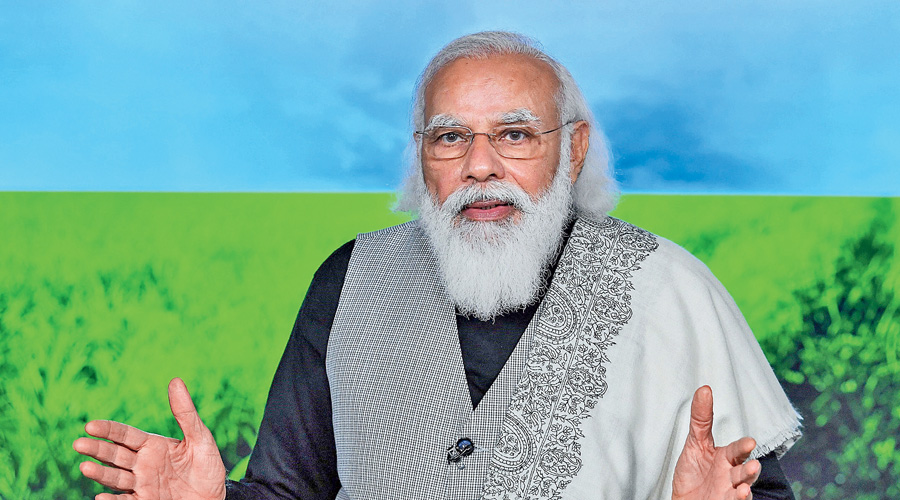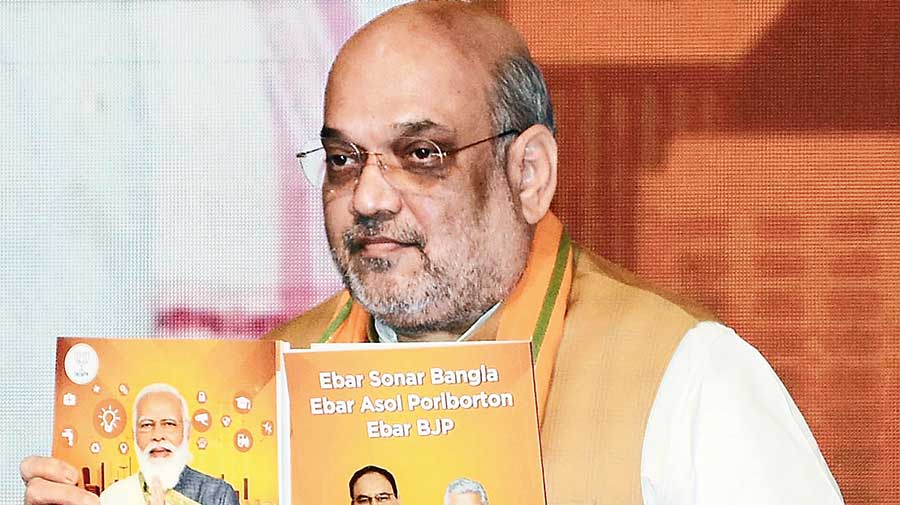The Assembly elections that will kick off this Saturday cover five states but it is Bengal that finds itself back in the national crosshairs exactly a decade after it sealed the fate of one of the longest running regimes in the world.
If Bengal was the cynosure in 2011 for voting out the Left after an unhindered and improbable run of 34 years, 2021 places the state at the centre of a battle that it did not start and a question only its voters can answer.
Will Mamata Banerjee be able to stop what has so far been the unstoppable juggernaut powered by Narendra Modi and Amit Shah? Or will the duopoly conquer the last frontier in the east, painting India with such a gigantic saffron brushstroke that only a sliver called Kerala will remain the sole holdout?
The once-hackneyed phrase — “the battle for the soul of Bengal” — has acquired some resonance and urgency because of the fear of the unknown and its unfamiliarity with the culture that has made Bengal what it is.
Toss into this cauldron concerns about abiding values such as personal liberties, communal harmony, cosmopolitanism, dissidence, the right to protest and minority rights — not to forget immediate issues such as farm laws — and you have one of the most significant electoral contests in recent memory.
The eight-phase elections scheduled to continue for over a month till April 29 will not only pave the way for the next government but also shape the course of politics in the eastern state.
The significance of the results, to be declared on May 2, will have consequences beyond Bengal’s borders, impacting the entire region’s geopolitical and geostrategic dynamics.
For Mamata Banerjee’s Trinamul, retaining power for the third time is paramount as she is aware that she needs to win to keep her party alive at a time the BJP is leaving no stone unturned to chip away by engineering defections.
For the BJP, a saffron Bengal is critical to establish a pan-India presence.
Ahead of the elections, the BJP’s focus has been to create the narrative that it is coming to power in Bengal — with 200-plus seats (the state has 294 seats). The party is also striving to create the impression that a “double-engine government”, at the Centre and in the state, will result in unprecedented growth.
Trinamul has fallen back on its most bankable asset — Mamata. By pitching herself as the party nominee in all 294 Assembly seats, she is travelling the length and breadth of Bengal, on a wheelchair and her leg plastered, and listing her achievements and countering the narrative spun by the “outsider” BJP.
The Telegraph takes a look at the factors that have made the contest so intriguing.
Turncoats galore
One of the most striking pre-poll developments in Bengal has been the exodus of leaders from Trinamul, and also from other parties, to the BJP.
Bengal had long been insulated from the “Aaya Ram, Gaya Ram” phenomenon, which loosely describes the politics of defections in India, till Trinamul began signing up legislators from Opposition parties after it came to power in 2011.
Cut to 2021, the BJP appears to have taken a leaf out of that book, effecting defections. Notable among the deserters have been former ministers Suvendu Adhikari and Rajeeb Banerjee.
The fact that the defections had nothing to do with ideology became clear when many of them made it to the candidate list of the BJP.
The overwhelming presence of turncoats — around 150 of the 283 BJP nominees announced till Saturday are from other parties — has triggered vehement protests from BJP old-timers across the state.
Two questions remain: (i) Will the turncoats deliver? (ii) Do the Trinamul faces in the BJP camp fit Narendra Modi’s narrative of bringing asol poriborton (real change) to Bengal?
All about identity
Identity politics, based on caste, language and ethnicity, to woo voters is another new phenomenon in Bengal, where class ruled the political discourse for years thanks to the Left.
Ahead of the polls, while Mamata has promised setting up of a special task force to seek reservation from the Centre for the Mahishyas, Tamus, Sahas and Tilis as OBCs, BJP president J.P. Nadda has said these communities deserve reservations. In doing so, both leaders were trying to court these communities, whose votes matter in East and West Midnapore, Howrah, Hooghly and the two 24-Parganas.
Trinamul and the BJP are also trying to win over the Matuas by spinning divergent narratives on the new citizenship matrix for electoral gains in 30-odd seats in Nadia and North 24-Parganas.
The Kurmis in Purulia and Bankura have also been showered with the promise of reservation for electoral dividends in 15-odd seats.
The battle for Rajbanshi votes in north Bengal has seen both parties competing to pay respect to Panchanan Barma and making promises for the uplift of the community and to recognise their language.
And, not to forget the contest to woo voters based on linguistic identities. Mamata has already announced that schools will be set up to promote languages other than Bengali and English and has even set up a Dalit Sahitya Academy.
But there are two questions: (i) Will there be caste-based conflicts? (ii) Will the focus on identities take Bengal back to the early 19th century when caste identities had cast a shadow on societal progress?
Temple tourism
Bengal had never seen such political temple tourism ahead of any election. Almost all the nominees of the major political parties — barring the Left, of course — are busy visiting shrines, especially Hindu temples. An estimate suggests Mamata and Suvendu, the contenders for the Nandigram seat, have visited at least 25 temples in the area. Not just the celebrity politicians, even the newcomers are making it a point to visit temples and pose for the cameras with red tilak on their forehead.
The significance of Jai Shri Ram and Bharat Mata Ki Jai slogans are being hotly debated. Mamata, who has been reciting sholaks and mantras at rallies, may have become a victim of competitive politics at a time the Prime Minister is accusing her of appeasing Muslims and not allowing Durga Puja immersions.
BJP insiders admit in private that they are happy with this change as the public display of Hindu identity and nationalism even by someone like Mamata means the Hindutva agenda has entered the political discourse of the state will remain firmly rooted there.
While the BJP is waiting to gain from the change, there are two questions: (i) Is this trend desirable in a plural society? (ii) Will the rise in Hindu nationalism result in conflicts in a region that has been immune to such tensions?

Narendra Modi File picture
Enter the consultant
Several political observers believe that Trinamul’s move to hire poll strategist Prashant Kishor’s I-Pac is a key addition to the poll game in Bengal.
Trinamul insiders think that the professional approach by Team I-Pac — with over 1,000 men and women working across 294 constituencies — has helped them better strategise for the elections.
The important questions here are: (i) Can all parties afford to appoint consultants? (ii) Is this trend of getting poll strategists here to stay?


